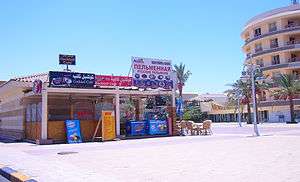Languages of Egypt
| Languages of Egypt | |
|---|---|
| Official languages | Modern Standard Arabic |
| Vernaculars | Egyptian Arabic (68%) (de facto lingua franca) |
| Minority languages | Sa'idi Arabic (29%), Bedouin Arabic (1.6%), Sudanese Arabic (0.6%), Domari (0.3%), Nobiin (0.3%), Bedawi (0.1%), Siwi, and Coptic (only for Coptic Christian rituals) |
| Main immigrant languages | Greek, Armenian, Italian |
| Main foreign languages | English and French |
| Sign languages | Egyptian Sign Language |
| Historical language(s) | Egyptian and its Coptic descendant |
| Life in Egypt |
|---|
 |
| Culture |
| Demography |
| Politics |
| Wildlife |
There are a number of languages spoken in Egypt, but Egyptian Arabic is by far the most widely spoken in the country. Arabic was adopted by the Egyptians after the Arab invasion of Egypt. [1]
Official language
The official language in Egypt is Modern Standard Arabic, used in most written documents.
Spoken languages
Arabic came to Egypt in the 7th century, and Egyptian Arabic has become the modern spoken language of the Egyptians and is understood by almost all Egyptians. In southern Egypt, Saidi Arabic is the main spoken language for most non-urbanized people. Of the many varieties of Arabic, Egyptian Arabic is the most widely understood first dialect in the Middle East-North Africa, probably due to the influence of Egyptian cinema throughout the Arabic-speaking world.
A Bedouin Arab minority speaks a variety of Bedouin Arabic mostly in the Sinai Peninsula. Sudanese Arabic is also spoken by the Sudanese minority.
Lingua franca
Egyptian Arabic is the commonly spoken language, and is occasionally written in Arabic script, or in Arabic chat alphabet mostly on new communication services.
Nubian languages
In the Upper Nile Valley, around Kom Ombo and Aswan, there are about 300,000 speakers of Nubian languages, mainly Nobiin, but also Kenuzi-Dongola.
Other languages of Egypt
Approximately 77,000 speakers of Beja live in the Eastern Desert and along the coast of the Red Sea.
Some 234,000 (2004) Dom speak the Domari language (an Indo-Aryan language related to Romany) and are concentrated north of Cairo and in Luxor.
About 30,000 Egyptian Berbers living in the Siwa oasis and its surroundings speak Siwi Berber,[2] which is a variety of the Berber language of North Africa. Siwi Berber is well mutually intelligible with Libyan Berber dialects. In ancient times, the population of western Egypt was probably made of Berber-speaking tribes.
Foreign languages
English is the most commonly used foreign language and most of the street plates are bilingual in Modern Standard Arabic and English. There are a few street plates with French instead of English. French is also widely spoken and used in business and educated circles.
In addition to English and French, Italian, German and Russian are widely used in the field of tourism.
During the period of the British colonization of Egypt French was actually the medium of communication among foreigners and between foreigners and Egyptians;[3] the mixed French-Egyptian civil courts operated in French, and government notices from the Egyptian Sultan, taxi stand information, timetables of trains, and other legal documents were issued in French.[4] This was partly because of some Egyptians had French education and partly because of cultural influence from France.[3] Despite efforts from British legal personnel, English was never adopted as a language of the Egyptian civil courts during the period of British influence.[5]
-

Bilingual Arabic-English sign in Cairo.
-
Bilingual Arabic-French street sign in Alexandria.
-

A market in Hurghada with a Russian language banner (on the right).
Historical languages
Other Egyptian languages (also known as Copto-Egyptian) consist of ancient Egyptian and Coptic, and form a separate branch among the family of Afro-Asiatic languages. The Egyptian language is among the first written languages, and is known from hieroglyphic inscriptions preserved on monuments and sheets of papyrus. The Coptic language, the only extant descendant of Egyptian, is today the liturgical language of the Coptic Orthodox Church.
The "Koiné" dialect of the Greek language was important in Hellenistic Alexandria, and was used in the philosophy and science of that culture, and was also studied by later Arabic scholars.
Notes
- ↑ http://www.historytoday.com/eamonn-gearon/arab-invasions-first-islamic-empire
- ↑ Siwi (siwi or žlan n isiwan) is a Berber language spoken at the oasis of Siwa in western Egypt (Matrūħ Province), about 500 km west of the Nile and 250 km south of the Mediterranean coast, by a little less than 15,000 people, forming a majority of the oasis' population. The nearest Egyptian oasis, Bahariyya, is some 350 km east of Siwa. Siwi is also spoken at the tiny oasis of Gāra near Siwa, and I was told of a multigenerational Siwi community at nearby Jaghbūb in Libya. page 16 of the book GRAMMATICAL CONTACT IN THE SAHARA: Arabic, Berber, and Songhay in Tabelbala and Siwa, August 2010, by: Lameen Souag.
- 1 2 Mak, Lanver. The British in Egypt: Community, Crime and Crises 1882-1922 (Volume 74 of International Library of Historical Studies). I.B.Tauris, March 15, 2012. ISBN 1848857098, 9781848857094. p. 87.
- ↑ Mak, Lanver. The British in Egypt: Community, Crime and Crises 1882-1922 (Volume 74 of International Library of Historical Studies). I.B.Tauris, March 15, 2012. ISBN 1848857098, 9781848857094. p. 87-88.
- ↑ Mak, Lanver. The British in Egypt: Community, Crime and Crises 1882-1922 (Volume 74 of International Library of Historical Studies). I.B.Tauris, March 15, 2012. ISBN 1848857098, 9781848857094. p. 89.
References
- Badawi, Mohamed; Caroli, Christian A. (2011), As-Sabil: Grundlagen der arabischen Grammatik (in German), Konstanz
- Bateson, Mary Catherine (2003), Arabic Language Handbook, Georgetown University Press, ISBN 0-87840-386-8
- Durand, Olivier; Langone, Angela D.; Mion, Giuliano (2010), Corso di Arabo Contemporaneo. Lingua Standard (in Italian), Milan: Hoepli, ISBN 978-88-203-4552-5
- Gregersen, Edgar A. (1977), Language in Africa, CRC Press, ISBN 0-677-04380-5
- Grigore, George (2007), L'arabe parlé à Mardin. Monographie d'un parler arabe périphérique, Bucharest: Editura Universitatii din Bucuresti, ISBN 978-973-737-249-9